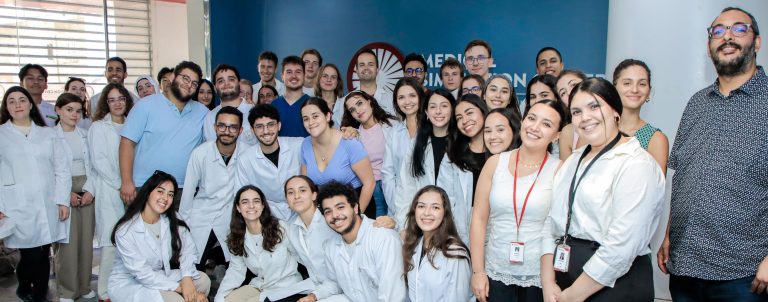History of Medical Simulation”, Habib Ben Ahmed, Chadli Dziri, La Tunisie Médicale Vol 98
- 13 octobre 2021
Habib Ben Ahmed, Chadli Dziri
La Tunisie Medicale – 2020; Vol 98 (n°012): 892-894 (French)
Simulation is an educational method in full expansion in the initial and continuing education of health (1). The concept of health simulation stems from “Never the first time on the patient” principle. Indeed, it is a tool for quality improvement, and safety of care by providing the opportunity to repeat clinical situations or therapeutic procedures in a secure environment. This method has proven its effectiveness, classical teaching methods that are essentially based on the companionship with the patient to the extent that it allows the rapid acquisition of technical and non-technical skills (2).
MEDICAL SIMULATION, An old HISTORY…
The simulation use has been described in medical education for a long time. About 800 before. B.C. Sushruta, an Indian surgeon recommends its students to train in the following areas incision, ligation and suturing using pieces of leather, tissue or lotus leaves. The means to do this are anesthetics were rudimentary; this training was effective in ensuring the speed and efficiency of the act and thus reduce pain. In Peru, skulls with bite holes have been discovered dating back to 1000-1250 CE. Curiously, the holes were made postmortem, which suggests that they were used by the practitioners of the time who has to improve their performance. In China around the year 1027, the emperor’s physician has manufactured adult-sized statuses for teaching anatomy and train young doctors in the art of acupuncture.
Besides, the Chinese society at that time was very conservative; the majority of physicians were men who could not directly examine women
The patient uses ivory or wooden figurine to show the area of pain or symptom. In the 16th century, Spain was ravaged by war to cope with the considerable number of injured people, Andrés Alcazar surgeon at the University of Salamanca introduced in 1570 the apprenticeship of reducing and fracture fixation using an adult sized wooden dummy.
Later, in 1763 the Italian juseppi Salernova used a model composed of a human skeleton and other materials to teach blood circulation. At the same time, life-size wax statues were used for the study of anatomy and obstetrics. It was not until the 18th century that one of the first and most important mannequins used for medical training. Indeed, in 1778 Angelique Du Coudray, a French midwife will use a life-sized women’s pelvis covered with fabric and leather and a doll of the size of a newborn to teach the art of childbirth (3). For twenty-five years, she travelled throughout France and has trained hundreds of midwives through the simulation. This midwife has thus made it possible, according to her famous formula, to “make the teaching palpable”. From 1910, Mrs. Chases (doll maker) will give her name to an articulated wooden mannequin of an adult female, which will be used for training in Nursing at Hartford Hospital School of Nursing in the United States of America. For more than half a century, generations of nursing students have learned the nursing care practice on this simulator (4). However, the era of modern medical simulation has been inaugurated by the work of Peter Safar. This resuscitator of the Baltimore City Hospital has been deeply marked by the death of his daughter at the age of 11 years from an asthma attack, will dedicate his life to the development and improvement of resuscitation techniques and maneuvers cardio-respiratory. In the early 1960s, this doctor teamed up with a Norwegian toy manufacturer, Asmund Laerdal, to develop the first cardiopulmonary resuscitation dummy. This is the world-famous dummy Resusci-Anne®. Initially limited to the teaching of the “mouth-to-mouth” technique, a thoracic spring was added secondarily to this dummy to allow simulation of cardiac massage (5). In 1967, Abrahamson and Denson presented the first computer-guided dummy, the “Sim One” intended for anesthesiologists in training. These two researchers from the University of Southern California have marked a decisive turning point in the history of simulators by inventing the current ancestor of high-fidelity mannequin (6).
At the same time, Michael Gordon also put the (on behalf of his mentor, Dr. Harvey), a dummy dedicated to cardiology which allows to simulate several cardiac pathologies, in particular valvulopathies (7). In parallel with the development of simulators, an American neurologist, Dr. Howard Barrows, will be introducing the concept of the standardized patient (an actor simulating a patient) The first “patient” will simulate a case of sclerosis in plates and this technique will be quickly adopted by North American medical schools (8). In the late 1990s, the programming development has allowed the development of different models and has led to the sophistication of mannequins more realistic and more adapted to the pedagogy. The explosion of digital technology will allow the emergence of the first virtual reality technologies dedicated to medical use. A milestone in the history of simulation was the publication, in 1999 in the United States of a medical report entitled “to Err is Human” which was originally an awareness in the world of health of the weight of the human factor in medical errors(9). This document reported that annually in the United States, approximately 90,000 patients die because of an error that could have been avoided (9). It is recommended to position medical simulation as one of the most important essential educational tools to reduce the frequency and the consequences of these errors by integrating it into the medical training.
At the beginning of the 2000s, the simulation that was initially intended to anesthesia and resuscitation will be extended to anesthesia and other specialties such as emergency medicine, pediatrics, obstetrics and various disciplines. The number of simulation centers in the world is growing. The World will then increase exponentially mainly in Anglo-Saxon countries. Thus from nowadays, in North America and some countries in the world, simulation is fully integrated into European programs of initial medical education and in the continuing professional development.
In Tunisia, in 1974 Professor Zouhair Essafi planned for his students, who had training in his surgical department of Charles Nicolle’s hospital, to do an exercise of external cardiac massage and mouth-to-mouth breathing on a low-fidelity simulator. After a shy start in medical schools, simulation is currently used with constant expansion. Several dedicated private centers to the training of health care professionals have made their appearance in the last ten years.
CONCLUSION
Medical simulation has experienced a considerable boom; it has become for several years an essential pedagogical method. It implies multiple modalities: from simple role-playing games to the most effective high fidelity mannequins. Development in our country of this age-old technique is a priority in the training of health care professionals because Preventable accidents are inconceivable in this day and age, less and less tolerated in a fast-paced society where the medical staff is the weakest link in the health care system.
RÉFÉRENCES
1- Granry JC, Moll MC. Rapport de mission. État de l’art (national et international) en matière de pratiques de simulation dans le domaine de la santé. Haute autorité de la santé. 2012.
2- Khanduja PK, Bould MD, Naik VN, Hladkowicz E, Boet S. Le rôle de la simulation dans la formation médicale continue pour les médecins de soins aigus : a revue systématique. Crit Care Med. 2015 ; 43:186-93.
3. Ammirati C, Ganry JC, Savoldelli G. Mannequins simulateurs de patients in : Boet S, Granry JC, Salvoldelli G eds. La simulation en santé. De la théorie à la pratique. Paris : Spinger-Verlag France ; 2013:63-74
4- Weir W. “Mrs. Chase” est une merveille médicale. Site web de Hartford Courant [Internet]. [Cité le 26 août 2016]. Disponible à l’adresse suivante : http://goo.gl/Tv2v9Q.
5- Safar P, Brown TC, Holtey WH, et al. Ventilation et circulation avec massage cardiaque à thorax fermé chez l’homme. JAMA 1961;176:574-6.
6- Denson J, Abrahamson S. Un simulateur de patient contrôlé par ordinateur JAMA 1969;208:504–8.
7- Gordon MS. Simulateur de patient en cardiologie : développement d’un mannequin pour enseigner les maladies cardiovasculaires. Am J Cardiol 1974;34:350-5.
8- Barrows HS, Abrahamson S. The Programmed Patient : a Technique for Évaluation des performances des étudiants en neurologie clinique. Journal de médecine l’éducation. 1964. p. 802–5.
9- Kohn LT, Corrigan JM, Donaldson MS. L’erreur est humaine : construire un monde plus sûr système de santé. Washington, DC : National Academy Press ; 1999.






